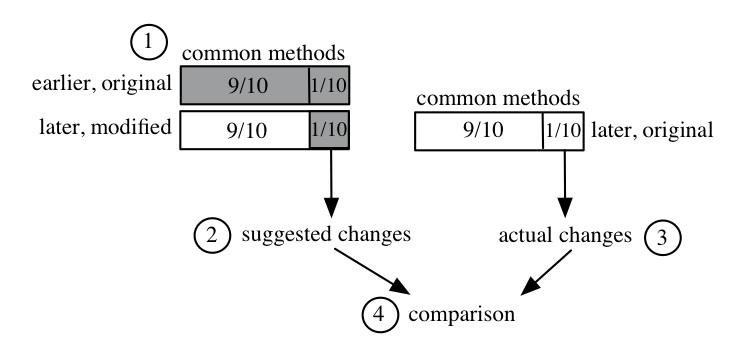
LAMARCK
Mining evolution usage patterns from object usage
Universität des Saarlandes – Informatik
Informatik Campus des Saarlandes
Campus E9 1 (CISPA)
66123 Saarbrücken
E-mail: zeller @ cs.uni-saarland.de
Telefon: +49 681 302-70970



Introduction
As software evolves, so does the interaction between its components. But how can we check if components are updated consistently? By abstracting object usage into temporal properties, we can learn evolution patterns that express how object usage evolves over time. Software can then be checked against these patterns, revealing code that is in need of update.Publications
- Yana Momchilova Mileva, Andrzej Wasylkowski, Andreas Zeller: Mining Evolution of Object Usage. Submitted to the 33rd International Conference on Software Engineering (ICSE) 2011. Hawaii, USA.
Evaluation
Test Subjects
We used Lamark to detect the evolution patterns from the evolution between those projects versions:- Experiment 1: Eclipse 1.0 to Eclipse 2.0
- Experiment 2: Eclipse 2.0 to Eclipse 2.1
- Experiment 3: AspectJ 1.6.0 to AspectJ 1.6.3
- Experiment 4: Azureus 4.1.0.0 to Azureus 4.4.0.0
Evaluation scenario
In order to perform a unbiased evaluation of Lamarck's performance we performed the following evaluation (illustrated on the Figure):
- Detect all the common methods between the first and the second versions of our test subject.
- Extract temporal properties from each of the two versions.
- Generate a random 1/10 vs. 9/10 split of all the common methods.
- Substitute the 1/10 methods' temporal properties in the second version with their corresponding old counterparts in the first version (i.e. reversing the changes between the two versions in these 1/10 methods).
- Create change properties from the difference in the temporal properties sets between the old version and the modified new version of the project.
- Using concept analysis, mine for frequently occuring evolution patterns (where any pattern that appears at more than 10 locations we consider a frequent one).
- Report all the patterns violations found by Lamarck in those 1/10 methods.
Lamarck's average precision ranges from 98% to 100%.
Evaluation Results
Here one can download the source code and the patterns for one random 1/10 vs. 9/10 split of the common methods between the two versions of our evaluation subjects for each of our four experiments.Experiment1.zip, Experiment2.zip, Experiment3.zip and Experiment4.zip.
Here one can download the .csv files with our results from all 50 random splits and runs for each one of the 4 experiments.
Contact us
Below you can find links to people working on mining evolution patterns. Please contact us for questions, rants, and raves.
Impressum ● Datenschutzerklärung
<webmaster@st.cs.uni-saarland.de> · http://www.st.cs.uni-saarland.de//models/lamarck/ · Stand: 2018-04-05 13:41